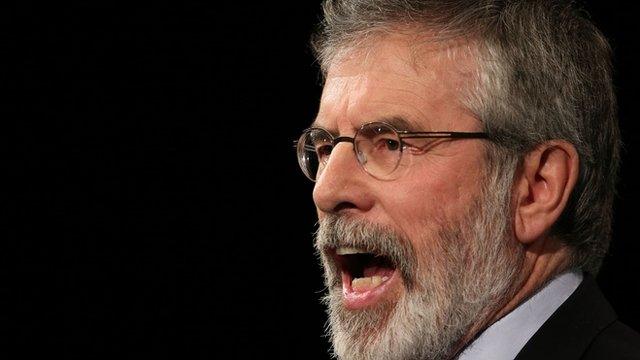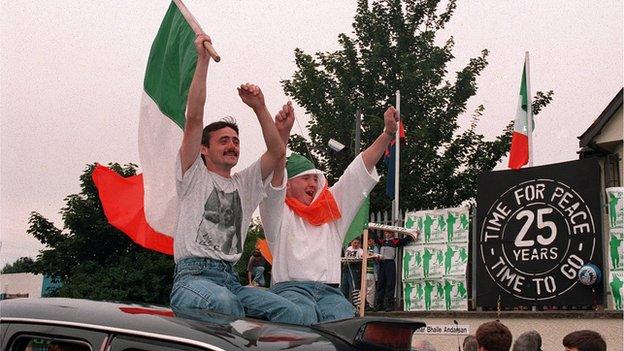Election profile: Sinn Féin
- Published
Sinn Féin is the biggest nationalist party in Northern Ireland.
Sinn Féin's name translates into English as "ourselves alone" and its policies have long been based on a revolutionary socialist analysis of Irish history.
The modern party developed following the split in the republican movement in 1971.
Then, the Provisional IRA (effectively republicans in Northern Ireland and the border areas) split from the Official IRA not long after the modern Troubles began.
Irish parliament


Gerry Adams has been the leader of Sinn Féin since 1983
It is also the only one of Stormont's main parties to stand candidates in elections in both Northern Ireland and the Republic of Ireland.
At Westminster, the party practices abstentionism. This means the party's five MPs do not take their seats in the House of Commons and refuse to swear the oath of allegiance to the Queen.
They do, however, have the right to House of Commons facilities, despite their abstentionist policy
They have 29 MLAs in the Northern Ireland Assembly and the party's Mid Ulster MLA Martin McGuinness is deputy first minister.
In 2007, following assembly elections after a period of direct rule, a deal was done between the DUP and Sinn Féin.
These parties formed a power-sharing executive, with Ian Paisley becoming first minister and Martin McGuinness becoming deputy first minister.
In the Irish parliament (Dáil Éireann), Sinn Féin has 14 members.
Party leader Gerry Adams is TD for Louth. Mr Adams stood down from the Northern Ireland Assembly and Westminster to stand for election in the Republic of Ireland in 2011.
IRA ceasefire


Sinn Fein's political stature grew following the IRA's ceasefire as it increasingly emphasised its support for the peace process
To cement its standing as an all-Ireland party, Sinn Féin fielded Martin McGuinness as its candidate in the Irish presidential election in 2011. He came third, winning nearly 14% of first preference votes.
Sinn Féin has frequently been asked if it might abandon its abstentionism, should it hold the balance of power in a future a hung parliament.
However, that has been ruled out by a series of Sinn Féin representatives.
The party was previously known as the political wing of the IRA and, although he has always denied being an IRA leader, Gerry Adams gained worldwide recognition as the face of the republican movement.
Party conference


At its 2015 Ard Fheis in March, Sinn Féin speakers concentrated on the 2016 Irish elections
Sinn Fein's political stature grew following the IRA's ceasefire in 1994 as it increasingly emphasised its support for the peace process and broader nationalist goals.
In the 2010 General Election, Michelle Gildernew retained her Fermanagh South Tyrone seat by just four votes, making it the constituency with the smallest majority in the UK.
The margin was reduced further, after a special court examined disputed votes, to just one vote.
At its 2015 Ard Fheis (party conference), Sinn Féin speakers concentrated on the 2016 Irish elections, rather than the Westminster contest.
Mr Adams told his supporters he wanted his party to lead the next government in the Republic of Ireland.